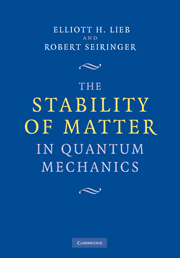Book contents
- Frontmatter
- Contents
- Preface
- 1 Prologue
- 2 Introduction to Elementary Quantum Mechanics and Stability of the First Kind
- 3 Many-Particle Systems and Stability of the Second Kind
- 4 Lieb–Thirring and Related Inequalities
- 5 Electrostatic Inequalities
- 6 An Estimation of the Indirect Part of the Coulomb Energy
- 7 Stability of Non-Relativistic Matter
- 8 Stability of Relativistic Matter
- 9 Magnetic Fields and the Pauli Operator
- 10 The Dirac Operator and the Brown–Ravenhall Model
- 11 Quantized Electromagnetic Fields and Stability of Matter
- 12 The Ionization Problem, and the Dependence of the Energy on N and M Separately
- 13 Gravitational Stability of White Dwarfs and Neutron Stars
- 14 The Thermodynamic Limit for Coulomb Systems
- List of Symbols
- Bibliography
- Index
14 - The Thermodynamic Limit for Coulomb Systems
Published online by Cambridge University Press: 20 December 2010
- Frontmatter
- Contents
- Preface
- 1 Prologue
- 2 Introduction to Elementary Quantum Mechanics and Stability of the First Kind
- 3 Many-Particle Systems and Stability of the Second Kind
- 4 Lieb–Thirring and Related Inequalities
- 5 Electrostatic Inequalities
- 6 An Estimation of the Indirect Part of the Coulomb Energy
- 7 Stability of Non-Relativistic Matter
- 8 Stability of Relativistic Matter
- 9 Magnetic Fields and the Pauli Operator
- 10 The Dirac Operator and the Brown–Ravenhall Model
- 11 Quantized Electromagnetic Fields and Stability of Matter
- 12 The Ionization Problem, and the Dependence of the Energy on N and M Separately
- 13 Gravitational Stability of White Dwarfs and Neutron Stars
- 14 The Thermodynamic Limit for Coulomb Systems
- List of Symbols
- Bibliography
- Index
Summary
Introduction
In the previous chapters we established the fact that the ground state energy is bounded below by a constant times the total particle number for a variety of models of particles interacting via electrostatic and magnetic forces. The natural next question would be whether it is strictly proportional to the particle number for large particle number, that is, whether the limit of the energy per particle exists. For the ground state energy it is actually easy to see that this is the case, as we shall demonstrate in Section 14.2.
A more interesting question is what happens if we confine a large number of particles to a large box, with the number of particles per unit volume, i.e., the density Q, fixed. Thiswould describe, for instance, a gas or a liquid or even a solid in a container. Again we expect the energy, in the limit of large system size, to be equal to the particle number times some function of the density, independent of the volume or the shape of the box. To make things even more realistic, one can discuss the very same question at a positive temperature T > 0, in which case the relevant quantity to look at is the free energy, i.e., the energy minus T times the entropy. This general question of the existence of the thermodynamic limit will be addressed in Section 14.3.
- Type
- Chapter
- Information
- The Stability of Matter in Quantum Mechanics , pp. 247 - 275Publisher: Cambridge University PressPrint publication year: 2009



